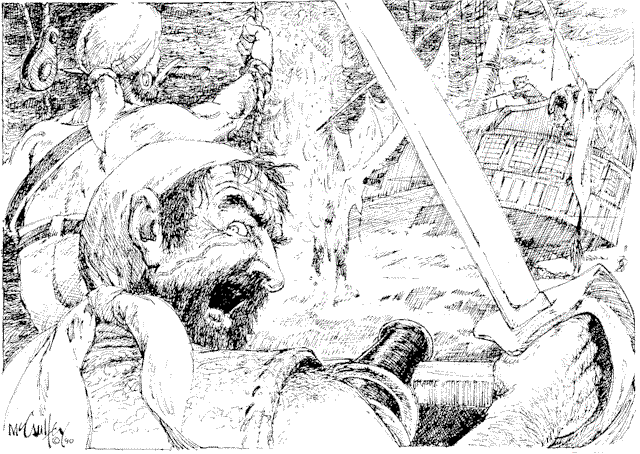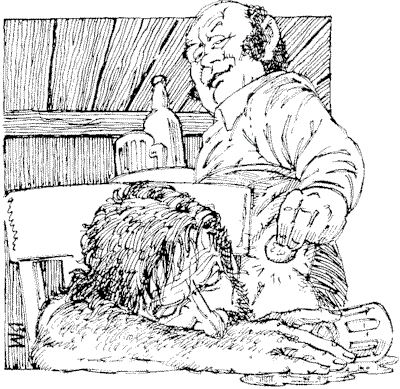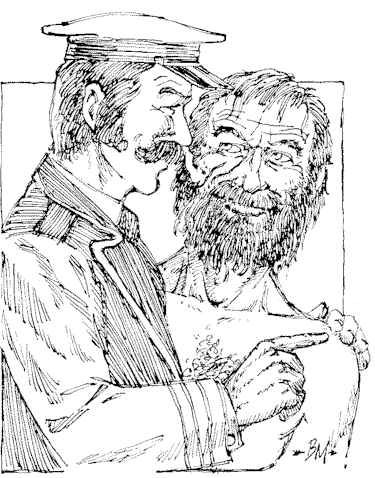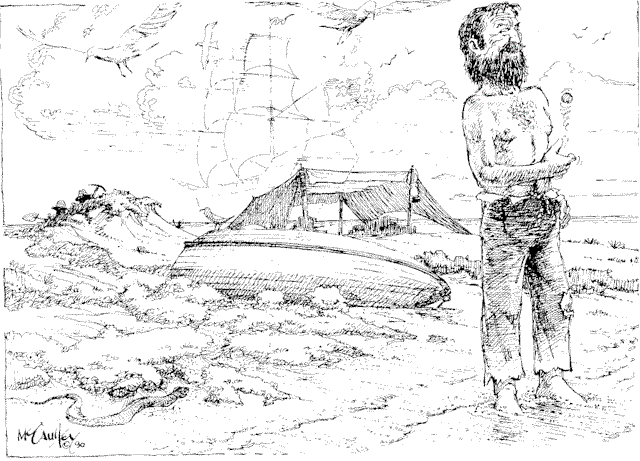"Crazy Ben" Dollivar's secret gold cache
By W. T. Block
Illustrated by Bud McCaulley
Whether one called it Galveston, as the residents did, or Campeachy or
'Snake Island," as the early buccaneers had dubbed it, it still added up to the same
25-mile-long sliver of sand which guarded the entrance to Galveston Bay. In 1815 a herd of
deer could be seen here or there, browsing on the lush grasses, but a more common sight
were the thousands of cotton-mouth snakes which slithered about on the shores.
A treeless expanse of windswept meadows and marshes, its single boon to
warrant human habitation stemmed from its strategic location, which soon enabled the
Island City to become the middleman of early Texas commerce. By 1850 Galveston had grown
to 5,000 persons, and the sails of every nation found their way to its wharves.

Along Strand and Tremont Streets, a few elegant carriages had already
furnished mute evidence of a rising cotton aristocracy, which collected the commodities of
the Texas plantations and trans-shipped them to New York and Europe. There was an old
world flavor during antebellum days as well, for along the waterfront and main
thoroughfares, the German language of the immigrants was spoken almost as frequently as
English.
And vestiges of the old pirate dominion also lingered on. The city
dwellers sometimes pointed out old Jim Campbell whenever he brought over a wagon load of
cotton or produce from Campbell's Bayou on the mainland. A legend in his own lifetime, old
Jim had been Jean Lafitte's favorite sea captain during his younger days and was a
respected citizen during his old age. Campbell's wife, Mary, had resided within the
corsair commune throughout the five long years of the island's pirate history.
Stephen Churchill, another holdover from the privateering days, ran the
ferry at the west end of the island. John Lambert, the town's leading butcher, was a tall
and powerful man, and like Campbell, both men were reluctant to discuss their careers as
buccaneers in the Gulf of Mexico. Sometimes the trio reminisced over a schooner of beer in
some remote corner of the Oyster Saloon, but always their conversations dwindled away to
stony silence if some stranger approached.
 But 'Crazy Ben' Dollivar was no stranger. Whenever he ambled up to
their table, the greetings and handshakes were genuine, and conversation flourished. Ben
had fought with them at the Battle of New Orleans and had shared their freebooter
experiences afloat. And on Capt. Campbell's last privateering voyage off the Mexican coast
aboard the 'Hotspur' in 1820, Ben had shared gunnery duties on a brass six-pounder with
Jean Callistre and Charlie Cronea.
But 'Crazy Ben' Dollivar was no stranger. Whenever he ambled up to
their table, the greetings and handshakes were genuine, and conversation flourished. Ben
had fought with them at the Battle of New Orleans and had shared their freebooter
experiences afloat. And on Capt. Campbell's last privateering voyage off the Mexican coast
aboard the 'Hotspur' in 1820, Ben had shared gunnery duties on a brass six-pounder with
Jean Callistre and Charlie Cronea.
If it were Ben's turn to pay for the drinks, his custom of paying
always with a Spanish gold doubloon had been witnessed in the Galveston saloons over a
span of twenty years. He never seemed to know, nor care, that the antique yellow coins
were worth twelve silver dollars each. When others were present to witness his money
transactions, the bartenders usually were cautious and returned the correct change in
coins, but if old Ben were alone and tipsy, they took full advantage of his condition to
short-change him.
Ben's nickname resulted from the fact that most Galvestonians
considered him as being 'tetched in the haid.' And being heavily scarred and uglier than
sin, his facial expressions easily added fuel to their arguments. Folks said, too, that
Ben sometimes muttered to himself or raved on incoherently, but if so, it was only noted
on those few occasions when his money outlasted his drinking capacity.
Another cause for the nickname stemmed from the fact that Ben's
lifestyle was different. He had no home and wanted none. Invariably he carried to town a
single gold doubloon for drinks, but never a cent for clothes or other necessities. And
for all the years that many people had known him, he had always walked to town barefooted,
wearing the same threadbare, homespun jeans which were held up by a short length of sail
rope tied at the waist.
Other Galvestonians, such as Campbell, Churchill, or Lambert, worked at
a trade and earned some measure of esteem in the community. But not so with Ben, who was
esteemed and respected by none, and being the town drunk or derelict, was scoffed at by
all.
You can wager, though, that every respectable mother's son or daughter
among them shared a common and burning passion to know the source of Ben's doubloons. Some
said that he had located a cache of Lafitte's treasure near his hangout on the north coast
of the island and somewhat west of the town, but even his ex-pirate companions did not
share the real secret.
Others tried to pry it away from him with a few swigs of stout whiskey,
but always Ben had a stock answer for his greedy interrogators. "Ah gits 'em,"
he would say, "from a big sea chest down in the "Hotspur's" bilge."
Reared an orphan, Ben knew almost nothing about his origins except that
he was born in Georgia during the middle 1780's. He grew up on the plantation of a cruel
uncle who, between floggings, worked him from daylight until dark in the cotton fields and
then read the Bible to him by candle light.
As a teenage lad, he ran away and joined a company of militiamen who
were pursuing a band of renegade Seminole Indians in the Florida Everglades. Later he went
to sea for many years, and on one voyage he fought a duel with another sailor which left a
6-inch saber scar extending from his right eye to a point behind his ear. And it was the
saber stroke, so some Galvestonians said, which had left Ben's intellect impaired.
In 1810 'Crazy Ben' became an artilleryman under Gen. Simon Bolivar
during a heroic but abortive attempt to free Venezuela from the Spanish yoke. And after
the revolution failed, it was while in hiding near New Cartegena that he first encountered
a pirate friend , Jean Baptiste Callistre, and joined the forces of Jean Lafitte, in whose
service both of them sailed for the next ten years and fought with at the Battle of New
Orleans.
Ben's long career afloat had taken him to almost every port on the
Atlantic Seaboard, the Caribbean, and the Gulf of Mexico. Long after his arrival at
Galveston, he would disappear for several days or weeks at a time, but always he would
return to his tent-like abode near the Island City. Folks sometimes said that he had gone
to the source of his wealth to replenish his supply of doubloons, but if so, his journeys
must have carried him to points as far away as New Orleans or elsewhere.
Perhaps it was his unconventional life style that some editors
considered to be newsworthy, for during the course of the nineteenth century, stories
about Ben Dollivar appeared in newspapers as far away as the Detroit 'Free Press.' In
July, 1847, the New Orleans 'Delta' published the following account of him, under the
headline of "One of Lafitte's Crew," as follows:
"Night before last, one of the guardians of the public peace
arraigned a little man named Benjamin Dollivar. The accused talked about boarding pikes
and cutlasses, 'pokes' or bags of silver in the hold, and diamonds and sacks of gold
dust."
"Dollivar's face looked like a piece of mahogany carved into human
semblance. His nose is sharp and crooked enough to have served as a boat hook in an
emergency, and his mouth, cheeks, and face are covered with a thick, dark beard. His
little grey eyes twinkled in their sockets with a semi-piratical ferocity."
"His forehead is scarred and full of wrinkles, and a seer might
discover in them lines written by vice on the tablet of crime. The police know him to be
one of the crew once under the command of the celebrated Lafitte, and if Prof. Ingresham
had been in the reporter's seat, he would have worked him up into a splendid old pirate in
a prize tale for one of our monthly magazines."
It's difficult to say whether Ben personally or Capt. Jim Campbell was
the more responsible for Dollivar's survival to old age. Whenever he could, old Jim
arrangedfor 'Crazy Ben' to enjoy a hot meal between his usual rations of grog. And when
Ben passed out in some alcoholic stupor, Campbell, until his death on May 5, 1856, would
load him into his wagon and return him to his north shore hideaway to 'sleep off the
fumes.'
 But Ben himself possessed a stamina akin to a bull buffalo, one which
defied the rain, cold, and wind. Oftentime during the month of January, the Galveston
beachcombers would see him swimming in the cold surf along the north shore of the island.
And when hunger approached, he would usually drag a small seine in the surf waters to
catch the few fish needed to sustain his health. Next to whiskey, his appetite craved raw
oysters, but raking the shellfish loose from the nearby reef and prying them open was an
exercise his aging energy has no lust for.
But Ben himself possessed a stamina akin to a bull buffalo, one which
defied the rain, cold, and wind. Oftentime during the month of January, the Galveston
beachcombers would see him swimming in the cold surf along the north shore of the island.
And when hunger approached, he would usually drag a small seine in the surf waters to
catch the few fish needed to sustain his health. Next to whiskey, his appetite craved raw
oysters, but raking the shellfish loose from the nearby reef and prying them open was an
exercise his aging energy has no lust for.
Ben's bayshore hovel was a lean-to, wooden framework, 10 feet square,
covered with sail cloth and opened at both ends to the north and south. Usually the
southerly breezes tempered the hot breath of the summers, but the chilling northers howled
through its openings during the cold months. The seasons, however, meant very little to
Ben, who seldom wore a shirt and no coat at all, and consequently became as bronzed as an
Indian.
When Ben was on the island, one could usually see an old whale boat,
turned upside down, on the sands beside his hovel. When the breezes were right, he would
sometimes hoist a mast and sloop sail on it and tack forth into the bay around Pelican
Island. During those sojourns when he left the island, he would sail away in it to the
source of his wealth on the mainland, but always he would return in a few days or weeks
with a new supply of doubloons.
Sometimes when 'Crazy Ben' returned to Galveston, he would find fresh
pot holes dug into the sands around his sailcloth hovel. Some townsman was always seeking
the place where Ben buried his gold coins. Ben buried his coins, all right, the same as he
hid whiskey jug, seine, sail, mast, shovel, and cooking utensils, but only at some
unlikely spot where some burrowing gopher might uncover it.
Ben's knack for taking care of himself is best portrayed in a story
that he once told to Capt. Campbell. In January 1837, Ben was riding horseback through the
Nueces River bottomlands en route to the ranch of an ex-pirate companion. The river was at
flood stage, and although half-drunk, he had ridden most of the day in water a foot deep.
When nightfall approached, he arrived at a high knoll of dry ground, a half-acre or so in
size, which he shared with scores of wolves, coyotes, and rattlesnakes.
A sharp norther blew in, and the temperature soon dropped well below
the freezing point. Knowing that he might otherwise perish of cold and exposure, Ben slit
his horse'ss throat and stomach, removed the intestines and other vital organs, and
climbed into the warm carcass to sleep. Later he claimed that he never knew for certain
whether he slept for one night or two, but when he awoke, two buzzards were pecking away
at his heels to let him know it was time to get up.
After Campbell's death in 1856, Ben grieved a lot for his erstwhile
companion, and his life style changed slightly. His trips to town became less frequent,
and when he did go, he usually slept off his drunken slumbers in jail or in the alley
behind the Oyster Saloon.
On one occasion, Steve Churchill invited him to spend his remaining
years with him at the West Pass Ferry, but Dollivar declined, preferring instead to
continue his solitude and simple existence on the north shore of the island. And so it
remained until July 1858, the month that a strange, clipper-built yacht sailed into
Galveston Bay and docked at Kuhn's Wharf.
To the numerous seamen and 'wharf rats' who watched from the shore, the
graceful vessel was a pearl-gray marvel of beauty. Everything about it smelled of newness.
The masts and spars were painted white, and from its sharp prow and raked foremast there
billowed forth a huge balloon sail or spinnaker of a type never previously seen at
Galveston Island. The name painted on its stern was "Sea Rover of New Orleans."
In sharp contrast to the yacht, the crew consisted of four grizzled and
bearded sailors of about age sixty and a young captain who stood tall and erect and wore a
black mustache. Steve Churchill was among those who watched from the wharf, and for a
fleeting moment, he thought he beheld his old buccaneer chieftain of 1820 returning to the
island.
After docking, the young captain came ashore and inquired, "Can
anyone help me locate old 'Crazy Ben' Dollivar?"
Churchill volunteered to lead the crewmen to Ben's hovel on the north
shore, where he left them to converse alone. Several hours later, Ben and the strangers
returned to the Dock 6 area, where they rented a small sloop and soon afterward sailed out
of the harbor. One sailor remained aboard the yacht as its watchman.

For the remainder of "Crazy Ben's" story, one must rely
heavily upon dockside gossip. An old longshoreman confided to Churchill a few days later
that Ben and the strangers returned to Kuhn's Wharf and transferred two rusty old sea
chests from the sloop to the decks of the yacht. The longshoreman added that as Dollivar
and the sailors embarked on the sleek vessel, Ben told him that he planned to spend his
last days in New Orleans. It seems that the young captain, who claimed to be Jean
Lafitte's nephew, had promised to care for Ben and supply him generously with whiskey
during his old age in exchange for the secret of the gold cache.
After the strangers hoisted anchor and sails and began the long tack
out of the harbor, Ben stood for a long time on the stern of the "Sea Rover" and
waved his sad farewells to his island home.
But somehow, Steve Churchill was much less optimistic about the old
pirate's future than the longshoreman was, or Ben himself for that matter. Churchill
feared that, as soon as the yacht reached the open sea, the sailors would probably murder
old Dollivar and throw his body overboard. Whatever his fate turned out to be, the
citizens of Galveston never saw or heard from "Crazy Ben" again.

Sold to and Copyrighted by TRUE WEST (May, 1990), pp. 26-29.
Also reprinted from Beaumont ENTERPRISE, July 5, 1978; Feb. 5, 1984 in different form.
Sources: "Lafitte and His Pirates," Galveston DAILY NEWS, April 21, 1878;
"Sailed With The Sea Rover," Galv. Daily News, Feb 7, 1909, and other articles.

